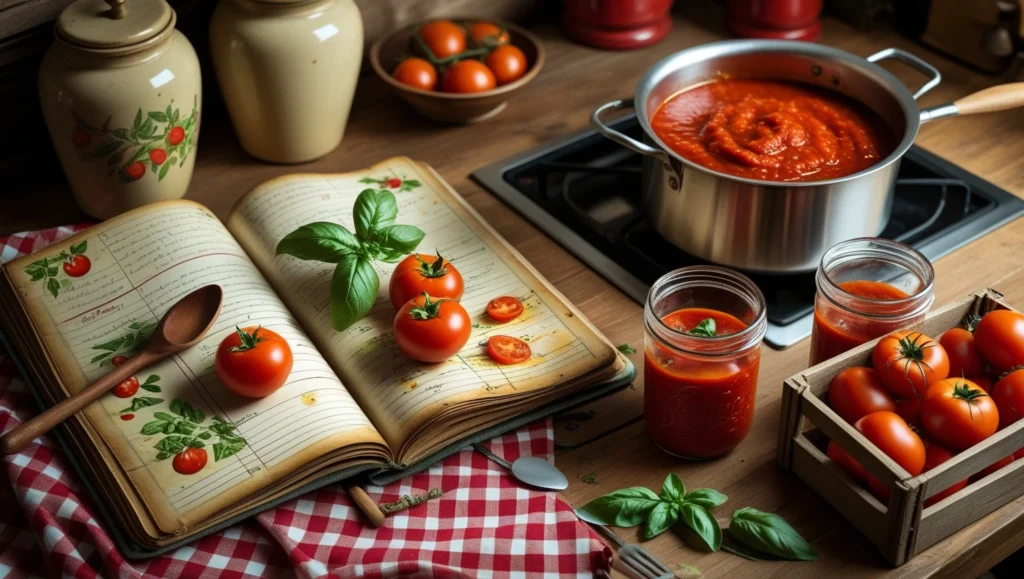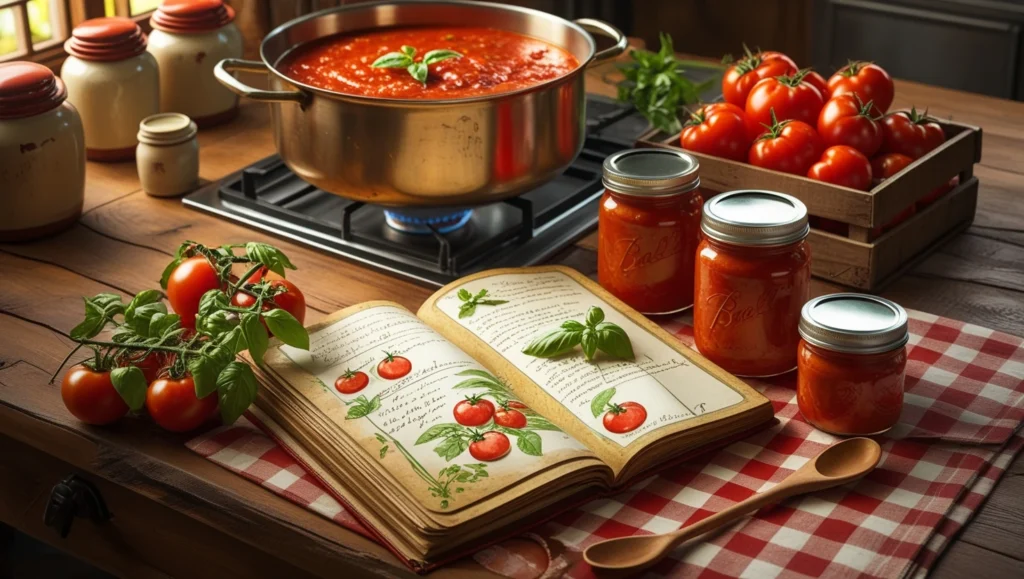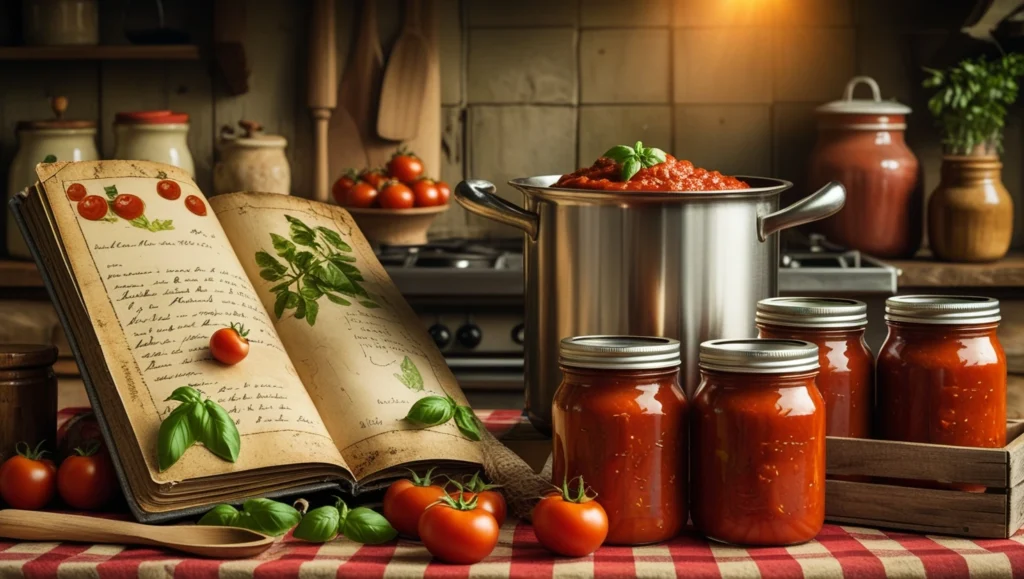Every summer, backyard tomato vines burst into life. Their ripe fruits are heavy with the promise of fall meals. Imagine simmering a pot of homemade sauce, filling your kitchen with garlic and basil scents. Then, seal that flavor in jars to enjoy months later.
Canning spaghetti sauce turns summer harvests into year-round comfort food. This tradition goes back to early 20th-century home canning. Families preserved tomatoes to enjoy summer’s taste in winter. Today, you can control every ingredient, from fresh tomatoes to herbs, without additives.
With the right steps, you can make a pantry staple that’s both economical and delicious. Canning spaghetti sauce isn’t just about preservation. It’s a skill that bridges seasons and builds self-reliance.
You’ll learn safe methods to ensure quality and safety, avoiding common pitfalls. This guide breaks down each step, from selecting tomatoes to mastering water bath or pressure canning techniques. Discover how a few hours of effort today means enjoying hearty, homemade sauce long after tomato plants fade.
Key Takeaways
- Learn to preserve summer’s bounty by canning spaghetti sauce for year-round use.
- Save money while avoiding preservatives found in store-bought jars.
- Control ingredients to tailor flavors with fresh herbs, spices, and quality tomatoes.
- Follow safe canning practices to ensure food safety and long shelf life.
- Adapt classic techniques to create a pantry staple through simple, step-by-step methods.

Benefits of Canning Spaghetti Sauce
Canning tomato sauce is more than just a pantry staple. It gives you fresh flavors all year and lets you control your diet.
Preserving the Summer Harvest
Tomatoes are at their best in summer, but their season is short. Canning tomato sauce helps you save summer’s flavors in jars. Enjoy fresh tomatoes in January or herbs in every batch.
This method also cuts down on food waste. It turns extra produce into lasting meals.
Cost Savings of Homemade Canned Sauce
Homemade sauce is cheaper than store-bought. Making your own can save up to 40%. Here’s a comparison based on USDA and Consumer Reports:
| Expense | Homemade | Store-Bought |
|---|---|---|
| Tomatoes (per gallon) | $6–$8 | N/A |
| Equipment costs (spread over 12 jars) | $1.25/jar | – |
| Total per jar cost | $2.75–$3.50 | $3.50–$5 |
A family using 24 jars a year saves $48–$96. This is great for big meals or pasta nights.
Control Over Ingredients and Flavors
Commercial sauces often have preservatives, too much salt, or sugar. With canning tomato sauce, you choose:
- Use organic ingredients or reduced-sodium options
- Add custom herbs like rosemary or red pepper flakes
- Avoid additives like citric acid or calcium chloride
Try new recipes: garlic sauces or roasted peppers. Each jar shows your taste.
Essential Equipment for Canning Spaghetti Sauce
Before you start your spaghetti sauce recipe for canning, make sure you have all the right tools. This ensures safety and success. The right equipment helps avoid mistakes and saves time.
- Canners: You’ll need a water bath canner for high-acid sauces or a pressure canner for thicker sauces. Both should be stainless steel or have a porcelain lining.
- Jars: Use Mason jars, either pint or quart sizes. Don’t use jars that have been used before. Brands like Ball or Kerr are good choices.
- Lids and Bands: New lids are essential for a good seal. Bands can be reused if they’re in good shape.
- Tools: Jar lifters, magnetic lid wands, and wide-mouth funnels make filling jars easier. A bubble remover tool helps remove air pockets.
| Tool | Purpose | Cost Range |
|---|---|---|
| Water Bath Canner | Process acidic sauces safely | $40–$80 |
| Pressure Canner | Necessary for low-acid recipes | $100–$200 |
| Canning Jars | Heat-safe storage containers | $10–$15 per dozen |
“Using proper equipment is the first step in safe home canning,” advises the USDA’s Complete Guide to Home Canning. Always sterilize jars by boiling them 10 minutes before use.
Optional tools like a food mill or immersion blender can make sauce preparation easier. A magnetic lid rack and headspace tool help with precision. Choose quality items from brands like Presto or Amazon Basics. Make sure all your equipment is ready before you start your spaghetti sauce recipe for canning to avoid any problems during the process.
Selecting Tomatoes and Ingredients
Choosing the right ingredients is key for safe and delicious home canned spaghetti sauce. Each ingredient, from tomatoes to acids, affects both taste and safety.
Best Tomato Varieties for Canning
Paste tomatoes are perfect for home canned spaghetti sauce because of their thick flesh and low water. Here are some top picks:
- Roma: Great for thick sauces
- San Marzano: Sweet, ideal for classic recipes
- Amish Paste: Less seeds, more pulp
Fresh vs. Store-Bought Ingredients
Here’s a comparison:
| Aspect | Fresh | Store-Bought |
|---|---|---|
| Flavor | Garden-fresh peak | Consistent quality |
| Cost | Gardening effort | Year-round access |
| Storage | Seasonal | Always available |
Optional Ingredients to Enhance Flavor
Enhance your sauce with these:
- Aromatics: Onions, garlic
- Herbs: Basil, oregano, parsley
- Veggies: Bell peppers, carrots, celery
- Seasonings: Salt, pepper, red pepper flakes
Make sure not to overpower the tomato base.
Safe Acidification Options
Acid levels must reach pH 4.6 or lower for safe home canned spaghetti sauce, advises the USDA.
Try these safe methods:
- Bottled lemon juice: 2 tbsp per pint jar
- Citric acid: 1/2 tsp per pint
- Distilled vinegar: 1 tbsp per pint
Don’t skip acid—low-acid environments risk botulism.
Preparing Your Homemade Spaghetti Sauce
Before you can your sauce, make sure the base is perfect. This ensures both safety and flavor in your canning spaghetti sauce. Each step is crucial to keep the quality high during preservation.
Blanching and Peeling Tomatoes
Begin by boiling whole tomatoes for 30-60 seconds. Then, cool them in an ice bath to stop cooking and loosen the skin. Peel off the skin with your fingers. If you want a smoother sauce, remove the seeds too.
Chopping and Sautéing Vegetables
Chop onions, garlic, and carrots into ¼-inch pieces for even cooking. Heat olive oil in a pot and sauté the aromatics until they’re translucent. Add herbs like basil or oregano. But don’t overcook to keep them fresh.
Simmering and Reducing Your Sauce
- Add crushed tomatoes and simmer uncovered over medium-low heat.
- Stir occasionally to prevent sticking; cook 45-60 minutes.
- Check consistency: sauce should coat a spoon without pooling.
Adjusting Seasonings and Acidity
Test the taste by spooning sauce onto cooked pasta. Add salt and pepper a little at a time. Use this table to know when to add herbs:
| Herb | Add During | Why? |
|---|---|---|
| Basil | Last 10 minutes | Preserve aroma |
| Oregano | Start of cooking | Deepen flavor |
Adjust acidity with lemon juice (1 tbsp per quart) if tomatoes are low-acid. This step is crucial for safe canning spaghetti sauce.

The Canning Spaghetti Sauce Process
Start by sterilizing jars in boiling water for 10 minutes. Follow USDA guidelines for safety. Fill hot canning tomato sauce into jars, leaving ½ inch headspace. Use a bubble remover tool to remove air pockets, then wipe rims clean with a towel.
- Place lids and bands on jars, securing them firmly but not overly tight.
- Process jars in a water bath or pressure canner. Times vary by altitude—check USDA charts for accuracy. Refer to section 7 for method specifics.
After processing, turn off heat and let jars sit in the canner for 5 more minutes. Remove jars using canning tongs and place on a towel. Listen for popping lids signaling seals forming. Allow jars to cool undisturbed for 12-24 hours.
Check seals by pressing the center of each lid. If unsealed, store the jar in the fridge and use within a week. Label sealed jars with dates and recipe details. Proper cooling prevents breakage and ensures safe canning tomato sauce.
Safety first: Never reuse lids from previous batches. Always adjust processing times based on your elevation. Over-tightening bands can interfere with proper sealing.
Water Bath vs. Pressure Canning Methods
Choosing between water bath and pressure canning depends on your recipe’s acidity. Can spaghetti sauce be canned in water bath? It depends on the ingredients. High-acid sauces (pH ≤4.6) can use a water bath. But, low-acid recipes need pressure canning to be safe.
When to Use Water Bath Canning
Use a water bath for high-acid spaghetti sauce. Recipes with lemon juice, vinegar, or citric acid (like traditional tomato-based sauces) are okay. Make sure pH is below 4.6 by testing or using USDA-approved formulas. Here’s how to do it:
- Boil jars in a pot of water covering jars by 1–2 inches.
- Process for 30–90 minutes depending on altitude and jar size.
When Pressure Canning is Required
Pressure canning is needed for low-acid sauces with meat, mushrooms, or extra vegetables. These ingredients lower acidity, posing a botulism risk. A pressure canner heats up to 240°F, killing harmful bacteria. Here’s what to do:
- Use a dial-gauge or weighted canner approved for home use.
- Process at 10–15 PSI, adjusting for altitude.
Safety Considerations for Each Method
Safety begins with knowing your recipe’s pH. Water bath failures in low-acid foods can lead to botulism. Always:
- Test sauce acidity with pH strips or follow tested recipes.
- Never guess—refer to USDA guidelines for processing times.
| Method | When to Use | Temperature | Risk Factors |
|---|---|---|---|
| Water Bath | High-acid sauces (pH ≤4.6) | 212°F (100°C) | Risk of spoilage if pH exceeds 4.6 |
| Pressure Canning | Low-acid sauces with meat/veggies | 240°F (116°C) | Botulism risk without proper pressure |
Safe Storage and Shelf Life
After your home canned spaghetti sauce cools and seals, it’s time to store it right. Remove the bands to stop rust. Then, clean the rims and label each jar with the date and what’s inside.
Keep jars in a cool, dark spot between 50°F and 70°F. Stay away from damp places and sunlight. This way, your sauce stays fresh and tasty. Stack jars upright to avoid damage.
Home canned spaghetti sauce stays good for 12–18 months if stored right. Even after that, it’s still safe if the seal is tight. But, the taste might not be as good. Always check for spoilage before using.
Watch out for these signs of trouble:
- Bulging lids or loose seals
- Unusual odors when opened
- Mold, foam, or off-color spots
Remember, if you’re unsure, throw it away. Use the oldest jars first. Keep track of your sauce with a simple list. This way, your homemade sauce will stay safe and tasty for a long time.
Troubleshooting Common Issues
Even with the best spaghetti sauce recipe for canning, minor problems can arise. Most issues are easy to resolve or prevent. Here’s how to handle the most frequent challenges:
Dealing with Separation in the Jar
Liquids settling at the bottom of the jar is common due to density differences. This doesn’t affect safety. To minimize separation:
- Blend sauce before canning for even texture
- Use low-acid tomatoes only in recipes with added lemon juice or vinegar
Addressing Discoloration
Dark spots or browning near jar lids occur from oxidation or natural caramelization. This is harmless. Prevent further changes by:
- Processing jars promptly after filling
- Storing in a cool, dark pantry
Preventing Spoilage
Mold (fuzzy growth), off smells, or swollen jars signal spoilage. Never taste or use these jars. Avoid risks by:
- Following exact processing times from USDA guidelines
- Ensuring pH stays below 4.6 with tested acidifiers like Ball® or Mrs. Wages® vinegar
Fixing Sealing Failures
If lids don’t seal, check:
- Rim cleanliness—wipe with a clean cloth before sealing
- Headspace accuracy—leave ½ inch (1cm) space between sauce and lid
- Jar edge damage—discard cracked jars immediately
Unsealed jars must be refrigerated and used within 3 days or reprocessed using fresh lids.
Remember: Cosmetic issues like separation or mild discoloration don’t compromise safety. Always prioritize USDA-approved spaghetti sauce recipe for canning steps to avoid risks. When in doubt, trust your senses—if jars smell bad or show visible mold, discard them promptly.
Creative Ways to Use Your Home Canned Spaghetti Sauce
Home canning spaghetti sauce is more than just for pasta. It can make any meal special. Try using it in new ways to surprise your taste buds.
- Pizza Perfection: Spread sauce on pizza dough for homemade pies. Add red pepper flakes or garlic for a twist.
- Comfort Food Classics: Simmer into lasagna, meatballs, or chicken parmesan. Its rich base becomes the star in layered dishes.
- Soups & Stews: Stir a jar into minestrone or chili. Use it as a base for hearty soups like Tuscan white bean or lentil.
- Global Flavors: Blend with coconut milk for a Thai-inspired curry, or mix with harissa paste for North African shakshuka.
Make your sauce fit each recipe. Thin it with broth for soups or thicken with cornstarch for braising meats. For a creamy touch, whisk in heavy cream to make a quick vodka sauce. Pair with fresh basil or Parmesan to match the dish’s needs.
“A well-stocked pantry with home-canned goods turns weeknight dinners into adventures.” — Chef Maria Lopez, canning expert
Share your creations by gifting jars in rustic burlap or twine. Label with recipe ideas like “Add sausage for spicy pasta” to inspire recipients. Pair with oregano or chili flakes for a personalized touch.
Plan weekly meals using canning spaghetti sauce as a base. Serve with roasted veggies for a quick dinner, or freeze portions of casserole mixes for later. Every jar becomes a shortcut to flavorful meals.
Conclusion
Canning tomato sauce is a great way to enjoy fresh flavors all year. It lets you control what goes into your food, save money, and keep summer’s best. Always make sure to sterilize jars safely and follow tested methods.
Start with a simple recipe to get the hang of it. Then, try adding herbs or peppers as you get better. This way, you can make your sauce your own.
Home canned spaghetti sauce connects you to old traditions but also fits today’s life. You can find reliable advice from the USDA and university Extension programs. Each jar is a sign of your hard work, bringing summer’s taste to any time of year.
Begin with a small batch in Ball jars or Le Parfait containers. Read the National Center for Home Food Preservation’s instructions before making more. Every jar you seal is a step towards cooking that’s good for the planet and your taste buds.
Ready to start? Get your ingredients and gear ready. Your future self will thank you for it.
FAQ
Can spaghetti sauce be canned in a water bath?
Yes, you can can spaghetti sauce in a water bath. But, it must be a high-acid recipe. This means adding lemon juice, vinegar, or citric acid to keep the pH level below 4.6. This is safe for water bath canning.
What is the best spaghetti sauce recipe for canning?
A great canning spaghetti sauce recipe includes paste tomatoes, onions, garlic, and herbs. Make sure to add enough acid to keep the pH level safe. Always use tested recipes from trusted sources for safety and quality.
How do I know if my home canned spaghetti sauce is safe to eat?
Check for proper sealing and look for signs of spoilage. Signs include bulging lids, off smells, or mold. If it’s sealed well and shows no spoilage, it’s likely safe to eat.
How long does home canned spaghetti sauce last?
Home canned spaghetti sauce can last 12-18 months. Store it in a cool, dark place. It might be safe longer if the jar is sealed and shows no spoilage.
What is the difference between water bath and pressure canning methods?
Water bath canning is for high-acid foods. Pressure canning is needed for low-acid foods. Pressure canning heats to safe temperatures for low-acid ingredients like meats and vegetables.
Do I need to add anything to my spaghetti sauce for canning?
Yes, adding an acidifying agent is crucial. Use bottled lemon juice or vinegar to keep the sauce’s pH level safe. Follow the recommended amounts for safety.
Can I use fresh herbs in my canned spaghetti sauce?
Yes, you can use fresh herbs. But, use them in moderation. Dried herbs keep their flavor better during canning.
What tomato varieties are best for canning spaghetti sauce?
Use paste tomato varieties like Roma, San Marzano, and Amish Paste. They have a high flesh-to-seed ratio and less moisture. This makes for a thicker sauce.
What equipment do I need for canning spaghetti sauce?
You’ll need canning jars, lids, bands, a water bath or pressure canner, a funnel, bubble remover, headspace tool, and large pots for sauce preparation.



